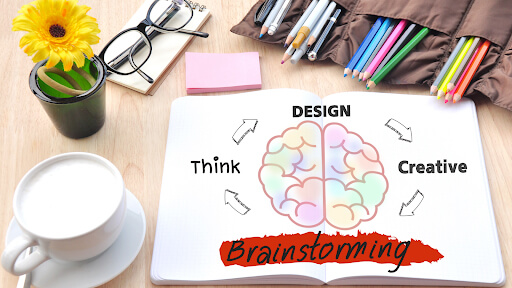 1-800-805-5783
1-800-805-5783  Design thinking goes beyond a framework or approach. You and your team can frequently overcome The most difficult problems through design thinking, with a successful solution at the other end.
Design thinking goes beyond a framework or approach. You and your team can frequently overcome The most difficult problems through design thinking, with a successful solution at the other end.
The value of design thinking has steadily risen in the contemporary world as time goes on. Modern customers have rapid access to international markets. The distinctions between physical and digital encounters are by design.
The mobile app design primarily affects your app’s user experience, which is why it is crucial to its success. The way your app appears and functions has a significant impact on how a user interacts with it.
Design thinking is a method that focuses on finding solutions and is essential for improving the user experience and comprehending what the user wants. It’s the capability to use competing viewpoints to generate new answers. It refers to striking a balance between a product’s desirability, technical viability, and economic viability. It also offers a fresh approach to solving the issues. The five steps of the iterative, human-centered design process are defining the problem, researching, ideation, prototyping, and testing.
Instead of focusing on problems, like in a problem-based approach, design thinking focuses on solutions. The problem-based approach focuses on identifying barriers and constraints that contribute to a problem’s existence.
Innovative thinking requires innovation and creativity to satisfy customers’ unmet needs. Every successful IT company knows UI and UX are vital to creating mobile apps that offer a distinctive user experience.
Consumers no longer distinguish between physical and digital experiences. Businesses can differentiate their goods or services from competitors. Companies can differentiate themselves from their rivals by creating a mobile application with a distinctive user experience. IT firms must build bridges between businesses and end users.
80% of millennials, according to statistics, have their smartphones with them at all times. They are unable to function without their cell phones. It is now more straightforward to use mobile applications because of how widely accessible the internet is. The current requirement is to have a mobile app.
Therefore, all companies that appeal to millennials and other customers and wish to succeed should create mobile apps. Mobile apps have completely changed and transformed the tech industry. In many marketers’ opinions, mobile apps are the simplest way to connect with clients and grow a brand. Additionally, it is simple to get direct feedback from customers.

Launching an MVP (minimal viable product) for businesses that prioritize design is ideal. In these situations, the company updates the product after considering user feedback and incorporating it into the design—for instance, on Facebook, Instagram, WhatsApp, and similar services.
It aids in developing profitable brands and the ROI from such brands. Because it takes a human-centered approach, design thinking focuses on the end users and how to improve and enrich the user experience. It involves diverse teams, so the advantage of collective wisdom, expertise, and knowledge is available while developing solutions.
It also entails coming up with creative solutions. As a result, this adds value for end users while addressing real issues.
Following the design thinking method or approach has notable advantages:

Empathize: Empathy is the first step in the design thinking process since it helps us understand the issue we’re trying to address. This stage is essential for knowing the user’s requirements in addition to the problem to provide a more specialized solution.
Comprehending the user’s behavior patterns, tendencies, preferences, and likely reactions to situations entails watching and interacting with the user. Once businesses fully understand the user environment and behavioral patterns, they can create solutions that address user needs.
Define: The procedure’s next step is to organize all the data gathered in the earlier stage. It will eventually assist you in defining the issue statement in a more human-centric way. The define stage aids in deconstructing complex concepts and problems and forms a systematic strategy for their resolution. This is the time to lay out the process and formulate the questions that must be addressed to solve the current problem.
Ideate: This is arguably the most crucial stage and, interestingly, offers the most creative freedom. This is the time to adopt an innovative mindset and prepare for experimentation to promote the user experience. At this point, bringing new ideas and considering inventive solutions to the problem is critical.
While proposing these solutions, it’s equally crucial to consider potential impediments that could arise from the user’s end and the environment.
Prototype: Making a prototype entails selecting and shaping your most fantastic ideas. Before proposing the idea for implementation, this step enables designers to evaluate the approach’s effectiveness internally in a small-scale setting.
It can also entail putting all potential ideas into action and assessing their efficacy. Eliminating all the unsuccessful or less effective solutions and moving forward with the best ones is a crucial component of this phase. Using prototypes, designers may create a more realistic solution that can be implemented on a larger scale by understanding how users would generally behave or react to a given key.
Test: The best options from the previous stage are tested in the last step of design thinking. Because this process is iterative, the outcomes of this stage are used to refine the final solution further.
The solutions found during the prototyping phase frequently undergo significant revisions or are even abandoned to match the needs of the actual environment’s users. The end product of this phase is a tried-and-true solution that can withstand environmental challenges and user expectations.
Obtain Knowledge And Exercise Keen Observation: One of the initial phases in the design thinking process would be to practice empathy, observation, and customer interviews to acquire ideas. The first step in producing goods or services for your customers is figuring out what they want.
Never make assumptions about people’s feelings or thoughts; instead, learn about their needs. Thus, keen observation and gaining insights are essential to the design thinking methodology.
Create And Implement An Unmet Needs Identification Methodology: A crucial step at the beginning is to build and plan a framework of ideas to understand the required needs. It can either be through a prototype or just a simple blueprint. Resources such as pen and paper or a slide deck are easily accessible and can be used to create a mock-up of ideas and get feedback.
It will help you understand your customers’ needs before investing in production. Companies can better understand and gain insights, which would, in turn, help them frame a better design thinking structure.
Transforming Our Issues Into Inquiries: When faced with an issue, our instinct is to solve it immediately. However, if we learn to change our thinking and attempt to ask questions, we might get closer to the problem’s source and make some progress.
Let’s use the case of a business having trouble with retention rates. How can we enhance the employee experience? They can raise this question. Focusing on human needs would reveal new information, leading to a more effective solution.
Use Reach To Comprehend The Past, Present, And Future: These research methods include empathy, observation, and interviewing. Advanced evaluative research concentrates on getting feedback on studies. Finally, conventional market research, or validating research, aims to comprehend what is occurring now. Maintaining a balance between the various research styles would enable us to concentrate on the now and look ahead.
Mobile app design thinking takes the form of a non-linear problem-solving process with anywhere between five and ten steps, even though, in theory, it comprises the three overlapping circles of inspiration, implementation, and creativity. There are numerous models with individual actions, but practitioners should be more relaxed about the procedure. An approach to an innovation known as “design thinking” seeks to connect the dots between business viability, technical prowess, and human values. Motivating yourself and your development team to think from the user’s perspective is the main guideline for applying a design thinking process to mobile app development. Utilizing the right tools and approaches is essential to effectively use design thinking in product development.